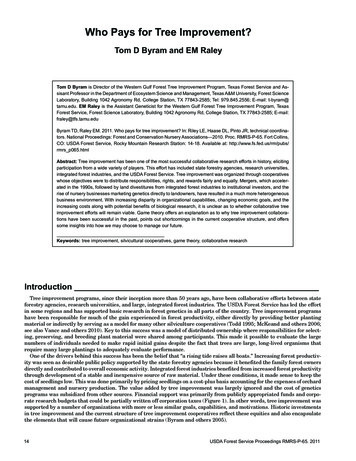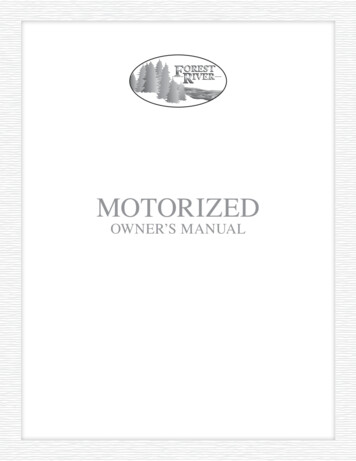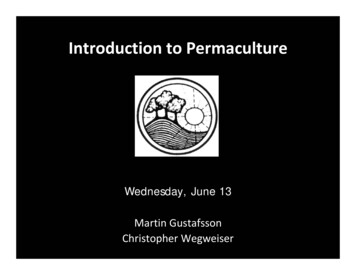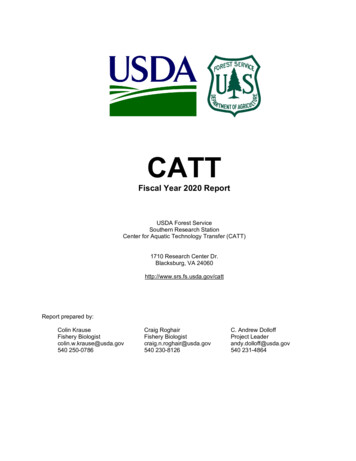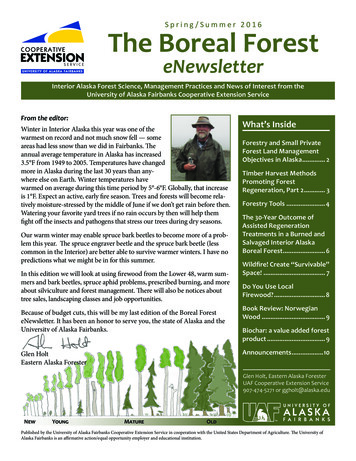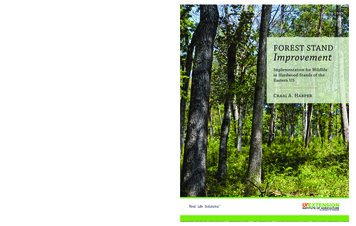
Transcription
PB 1885FOREST STANDImprovementImplementation for Wildlifein Hardwood Stands of theEastern USCraig A. HarperPB 1885 (10/20) Programs in agriculture and natural resources, 4-H youth development,family and consumer sciences, and resource development. University of TennesseeInstitute of Agriculture, US Department of Agriculture, and county governmentscooperating. UT Extension provides equal opportunities in programs and employment.Disclaimer: This publication contains pesticide recommendations that are subject to change atany time.The recommendations in this publication are provided only as a guide. It is always thepesticide applicator’s responsibility, by law, to read and follow all current label directions forthe specific pesticide being used. The label always takes precedence over the recommendationsfound in this publication.Use of trade or brand names in this publication is for clarity and information; it does not implyapproval of the product to the exclusion of others that may be of similar, suitable composition,nor does it guarantee or warrant the standard of the product. The author, the University ofTennessee Institute of Agriculture, and University of Tennessee Extension assume no liabilityresulting from the use of these recommendations.
Forest Stand ImprovementImplementation for Wildlife in Hardwood Stands of the Eastern USCraig A. Harper
Forest Stand Improvement: Implementation for Wildlife inHardwood Stands of the Eastern USCraig A. Harper 2020 Craig A. HarperUniversity of Tennessee ExtensionThe University of Tennessee Institute of AgricultureKnoxville, Tennessee 37996utia.tennessee.eduPhotos by C.A. Harper except where noted.Produced by University of Tennessee Institute of AgricultureDepartment of Forestry, Wildlife and FisheriesPrinted by SheridanPrinted in the United States of America
CO NT E NT SWhat is Forest Stand Improvement? 1When should FSI be put into practice? 1What’s the difference between thinnings and cuts? 1Can trees in a thinning or cut be harvested for wood products? 2If trees are not harvested, how are they killed or removed? 3How much time does it take to implement FSI? 5Influencing understory composition with herbicide applications 6Which tree species should be retained? 8Which trees should be felled and not treated with herbicide? 8How many trees should be cut or killed? 9Recommendations for percent sunlight vs. target basal area 14Tree spacing 14What if all the trees are desirable species? 15What about fire? 18How does hinge-cutting fit in? 25Managing your “woods roads” 26Conclusions 30Acknowledgements 30References 31
WHAT IS FOREST STAND IMPROVEMENT?Forest stand improvement (FSI) composespractices that guide or influence a forest standto meet a particular objective, such as improvinghabitat for various wildlife species, changingplant species composition, or influencing thestructure and visibility within a stand to meetaesthetic objectives. FSI does not necessarilyinvolve timber considerations as does timberstand improvement (TSI), including tree value,volume or merchantability, though it may. FSIdoes not involve regeneration methods (such asclearcut, shelterwood or group selection) thatestablish a new stand, but instead represents anynon-regeneration practice to make an existingstand better for a particular objective. As such,FSI may involve various types of thinnings, cuts,prescribed fire and herbicide applications.This publication is intended to highlightvarious applications of FSI when wildlifeis the primary objective. In particular, manylandowners are interested in improving theirwoods for wildlife, but either 1) they are notinterested in a regeneration harvest (do not want tosee a majority of the trees harvested), 2) the standis not ready to regenerate (either not old enough orthere is a lack of advanced regeneration of desirabletrees, such as oaks), or 3) the trees do not haveenough value to attract a logger. Indeed, manyforest landowners have relatively little interest intimber value. The interests of many landownersconcentrate on the abundance, visibility andhuntability of certain wildlife species. FSI is aterm that encompasses practices and techniqueslandowners can use to improve their woods forwildlife or to achieve other objectives, includingaesthetics. The information, recommendationsand ideas that follow were generated by researchconducted by several of my graduate students aswell as the extensive work we have conducted ondemonstration areas over the past 20-plus years.WHEN SHOULD FSI BE PUT INTOPRACTICE?You may implement FSI anytime conditions ina particular stand do not meet your objectives.For example, a mature oak-hickory stand may beready to regenerate, but instead, FSI through animprovement cut and prescribed fire may be mostappropriate to meet your objectives of improvingforage availability and fawning cover for whitetailed deer. FSI through girdle-and-spray or anunderstory broadcast herbicide application maybe used to control nonnative, invasive plantspecies, including trees, shrubs, woody vinesor herbaceous species. FSI through a thinningoperation, whether harvesting, felling or hackand-squirt, may be used to encourage additionalgrowth of desired tree species (consistent withTSI) or increase the amount of sunlight enteringthe stand to stimulate understory developmentfor various wildlife species. There are manyexamples and levels of implementation of FSIthat may be used to meet specific objectives.Various FSI techniques, such as a foliar spotspray treatment, may be most appropriate duringspecific seasons of the year, but there are FSIpractices that can be implemented any time ofyear depending on your objectives and currentstand conditions.WHAT’S THE DIFFERENCE BETWEENTHINNINGS AND CUTS?Thinnings are conducted in immature stands withthe primary intention of improving growth andvolume of remaining (retention) trees or increasingthe amount of sunlight entering the stand. Cutsare made to more mature stands to improve speciesFig 1. FSI involves practices that improve speciescomposition and vegetation structure in a particularstand to meet your objectives. Here, undesirable treespecies have been cut or killed and prescribed fire hasbeen used to influence the composition and structure ofthe understory to increase food and cover for whitetailed deer and wild turkey.1
composition, allow additional space for crownsof remaining trees, and to add sunlight to theforest floor in order to stimulate the understory orinfluence the structure of the stand.However, tree value is relative. If you are wantingto improve your woods for deer and turkeys,for example, you likely would retain high-valuefood trees, such as oaks, persimmon, mulberryand various other mast producers. And theremay be high-value timber trees, such as yellowpoplar, walnut, hickory, sugar maple and others(depending on current market), that you wouldwant a logger to remove because the value of thosespecies relative to your objective of improvinghabitat for deer and turkeys is low. If easterngray squirrel and black bear are focal species,then you may retain a majority of the hickories. Ifvarious songbirds are of interest, then promotingtrees that provide fruit, such as hackberry, blackcherry, flowering dogwood, American holly,sassafras, blackgum and serviceberry, will benefitmany species, including gray catbird, Baltimoreoriole, American robin and other thrushes, brownthrasher, cedar waxwing, Northern mockingbird,Northern flicker, and summer tanager. Again,value is relative to your objectives, and there isnothing wrong with managing your forest to meetyour objectives, even if your objectives are nottimber-value related! Another consideration isthe impact of logging, including ruts made fromlogging equipment and damage to residual trees.Fig 2. This 8-year-old regenerating mixed-hardwoodstand could go in a number of directions at this point.Depending on your objectives, various managementpractices could be implemented. For example, aprecommercial thinning could be implemented to releasedesirable species, such as oaks, for future timber ormast production. Undesirable trees could be killed byhack-and-squirt, basal bark treatment or felling, uponwhich stumps may or may not be treated to preventsprouting. The stand could be burned with moderatelyintense fire to top-kill all stems if the objective wasto maintain dense stem structure for deer, grouse orshrubland songbirds. A low-intensity fire could beused to top-kill some trees and encourage understorydevelopment. A combination of thinning and fire couldbe used to ensure the trees that live are desirable andbegin the process of creating an oak woodland. Thereis no one treatment that is best for all objectives. Thecorrect treatment is dependent upon your objectives!CAN TREES IN A THINNING OR CUT BEHARVESTED FOR WOOD PRODUCTS?Sure, depending on the species, size and qualityof the trees removed. In pine stands, thinningscommonly involve harvest that generate incomefor the landowner. However, in hardwood stands,trees removed often are low-quality speciesor relatively small stems that loggers will notharvest because those trees will not pay theirway out of the woods. Thus, you may have toallow loggers to harvest some high-value treesin order for them to fell (cut down) or harvestthe low-value trees you would like removed.Fig 3. Depending upon species, size, form and availablemarket, undesirable trees can be harvested through animprovement cut. However, often the undesirable treesyou would like removed, such as red maple, sourwood,sassafras, elm, and even yellow-poplar and hickory,may have low value, and it is difficult to entice a loggerto harvest them without harvesting higher-value trees.2
For example, it is not uncommon for loggers todrag harvested trees against the stem of retainedtrees, damaging the base of retained trees andallowing insects or fungi to enter the tree andreduce quality or even lead to tree mortality. Ifthat is a concern, you can include a requirementin your timber sale contract that felled trees mustbe cut to length before skidding to minimizedamage to residual trees, but some damage will beinevitable. Therefore, according to your objectivesand financial considerations, it may be best tokill or fell undesirable trees yourself rather thanhaving them harvested by a logger.IF TREES ARE NOT HARVESTED, HOWARE THEY KILLED OR REMOVED?Trees may be felled using a chainsaw or they maybe killed and left standing via girdle-and-sprayor hack-and-squirt. I prefer to girdle-and-sprayusing a small chainsaw, as opposed to using ahatchet for hack-and-squirt, because it allowsthe option of felling trees. Girdling involvesmaking a shallow cut severing the inner barklayer (cambium) all the way around the tree. Anherbicide then is sprayed into the wound to ensurethe tree dies. Hack-and-squirt involves using amachete or a hatchet, severing the inner barklayer with angled cuts (about 45-degree angle)around the tree approximately 3 inches apart.An herbicide then is sprayed into the wounds. Alight squeeze with a squirt bottle held closely tothe girdle or hack is all that’s needed to moistenthe wound all the way around the tree or in eachhack. Applying more herbicide than is necessaryto moisten the wound, such that it drips orruns down the trunk from the girdle or hack isexcessive and wasted. The herbicide should beapplied while the wound is still fresh and priorto surface hardening (usually within an hour) tohelp ensure the herbicide is able to soak into thewound. Trees also can be injected with herbicideusing an injection gun.Fig 4a, b and c. Girdling a tree and spraying the wound with an appropriate herbicide is an efficient method to kill thetree without felling. A shallow girdle is all that is needed to sever the cambium layer (a). Herbicide applied should wetthe cambium. A blue dye can be added to the herbicide mixture to help make it more noticeable if you missed any trees.Trees with double trunks, such as this sweetgum, can be girdled below the split to prevent having to girdle both stems(b). Hack-and-squirt also is effective (c), but you have the option of felling smaller trees if you girdle-and-spray with asmall chainsaw vs. using a hatchet or machete to hack-and-squirt.3
Arsenal contains imazapyr,which is soil active, so isthere concern about killingnontarget trees?No, not with the mixture, rate andmethod described above. The rareexception is when killing a treethat may be a sprout arising from ashared root system of an adjacenttree of the same species, such assweetgum or aspen, and even thenit is rare to see a nontarget treekilled with the mixture and methoddescribed above.Fig 5. There is no danger in killingnontarget trees that are not growingfrom the same root system with the 50percent Garlon 3A/40 percent water/10percent Arsenal AC herbicide mixturewhen used as described in the text. Hereare two red maples that were treatedand killed with the mixture growingadjacent to two northern red oaks,which were not harmed and now theircrowns are released and free to growlarger, thus enabling them to producemore acorns.4
There are several herbicides that can be usedto kill various tree species via girdle-and-sprayor hack-and-squirt and to treat the inner barklayer of stumps of felled trees to prevent themfrom sprouting. I prefer a mixture of triclopyr andimazapyr. I typically use Garlon 3A (50 percent),water (40 percent) and Arsenal AC (10 percent),mixed in that order by volume. I use this mixturebecause various herbicides are weak on various treespecies. For example, Garlon 3A, which containstriclopyr, is weak on hickory, sourwood and blackcherry. Arsenal AC, which contains imazapyr, isweak on leguminous species, such as honeylocust,black locust, mimosa and redbud, as well as elms,wax myrtle, pines and eastern redcedar. A mixtureof triclopyr and imazapyr kills a broad spectrum oftree species, which is advantageous when treatingstands of mixed species. However, a mixture ofherbicides is not necessary if all the trees in thestand you are treating can be killed with a singleherbicide. Refer to herbicide labels regarding useand susceptible tree species.Trees treated by girdling and sprayingtypically die over a 3- to 4-month period. Treescan be treated at any time of year, and treatmentis equally effective at all times, except early springwhen some species, such as maples, may haveactively flowing sap. In those instances, when thetree is girdled, the sap can flow so heavily from thewound that the herbicide is washed out. In general,most trees treated in fall and early winter willnot leaf-out the following spring. If implementedin late winter, all will leaf-out in spring, butthey slowly die over the next couple months. Ifimplemented in spring, trees slowly die throughsummer. If implemented in summer, they slowlydie and drop their leaves in fall, but do not leaf-outthe following spring. Fall and winter are excellenttimes to work in the woods because of the coolertemperatures, but spring and summer also are goodtimes because trees are more easily identified withthe leaves present. I keep a small chainsaw andsquirt bottle with herbicide mixture in the truck orATV anytime I’m working on a property and treatundesirable species as I see them.Treatment cost for girdle-and-spray variesdepending on the number and size of trees treated.At the rate mentioned above, a 24-oz spray bottleof the herbicide mixture costs about 8. Onaverage, you can treat 1-2 acres of most typicalmixed hardwood stands to allow 20-30 percentsunlight into the stand using one 24-oz spraybottle of herbicide.HOW MUCH TIME DOES IT TAKE TOIMPLEMENT FSI?As you might imagine, time required to implementFSI is highly dependent on what you are doing.Felling trees greater than 12 inches dbh generallytakes more time than girdle-and-spray or hackand-squirt. Young stands typically take moretime to reduce canopy cover to allow a certainamount of sunlight into the stand than an olderstand with fewer trees. Hinge-cutting (describedbelow) requires more time than girdling-andspraying, but the effect is different. Treating astand with a chainsaw typically requires moretime than burning, but burning can require moretime than chainsawing if you consider time toestablish firebreaks and especially if the firegets into unintended areas! However, to providesome general time frame, I have found that whentreating an “average” mature, closed-canopy,mixed hardwood stand via girdle-and-spray toallow approximately 30 percent sunlight into theforest floor, you can treat about 8 acres in a shortwinter day with two people (one operating thechainsaw and one squirting the girdled trees andstumps). Indeed, just one person with a chainsawor hatchet and a squirt bottle can implement somelevel of positive change over 10 acres in a day withno problem. More intensive work incorporatinggirdle-and-spray, felling and hinge-cutting tocreate a “bedding block” for deer in a relativelydense stand will take more time, but two peopleworking together still can create a superattractive 10- to 15-acre area to hold deer on aproperty in only a couple of days.5
What about basalbark applications?Basal-bark applications can be usedin young stands to control speciescomposition and allow selectedstems more room to grow. Basal-barkapplications typically employ a triclopyrbased herbicide with an oil carrier ordiesel fuel. It is sprayed on the lower18-24 inches of a tree trunk. The oilor diesel fuel enables absorption ofthe herbicide through the bark. Basalbark applications are made to youngtrees because the bark of young trees isrelatively thin and absorption throughthe bark is much easier and moreeffective than if applied to relativelythick bark. Basal-bark applicationsare very effective and efficient tocontrol undesirable trees up to about 4inches in diameter and too tall to treatwith a foliar application. Basal-barkapplications are most often implementedin winter, but they can be applied anytime of year.Fig 6. Basal bark applications are most effectivewhen applied to young trees with thin bark.However, relatively large trees with thin barkalso are susceptible, such as this sycamore,which was killed to favor an adjacent oak notseen in the picture.INFLUENCING UNDERSTORYCOMPOSITION WITH HERBICIDEAPPLICATIONSHerbicide applications can be used to controlnonnative invasive and other undesirable plantspecies or to reduce woody cover and promotemore herbaceous plants in the understory.Spot-spraying is appropriate in the majority ofsituations, but there are times when a broadcastapplication is warranted. Broadcast applicationsusing an ATV with a boomless nozzle are possiblein some situations, but tree spacing, slope, andterrain make broadcast applications with anATV difficult if not impossible in many cases.Most often, herbicide applications in the woodsare made with a backpack sprayer. Although itmay seem overwhelming if you have never doneit, do not overlook use of a backpack sprayer toimprove plant composition in the understory. Youcan cover a lot of ground in your woods by spotspraying foliage of undesirable species with a4-gallon backpack sprayer! Different nozzles andspray-gun attachments may be used depending onthe problem plant species.Various soil-active herbicides, includingimazapyr, should not be used when implementingbroadcast applications because of potentialdamage to desirable overstory trees. However,glyphosate and triclopyr are not soil active andwork very well as a foliar application to control6
most undesirable plants, including Orientalbittersweet, garlic mustard, English ivy, Chineseprivet, bush honeysuckle, multiflora rose, autumnolive and shrub lespedeza. Foliar applicationsusing a 4-5 percent solution of a glyphosate ortriclopyr herbicide are recommended for mostwoody plants, but you should always read andfollow label directions.Fig 7. A backpack sprayer with a GreenGard spray gunis efficient and effective to treat problem plants, suchas Chinese privet and bush honeysuckle, which mayrequire a spray distance of 30 feet or more.Fig 8a, b and c. Oriental bittersweet had overtakenthe understory of this stand (a), essentially requiring abroadcast application of Garlon 3A, which was appliedusing a backpack sprayer with a simple spray wand witha flat-fan nozzle. One month later (b), the Orientalbittersweet was eradicated. One growing season later(c), native groundcover flourished. However, be aware:a single application is never all that is needed. How didthe bittersweet get there? Birds. Will they deposit moreseed back later? You bet. And you must sever and treatall the large, bittersweet vines that are growing up inthe tree crowns producing fruit. You must be diligenttreating nonnative invasive species in your woods. It isnever a single event, but an ongoing process.7
WHICH TREE SPECIES SHOULDBE RETAINED?In general, species that provide an importantfood source for the focal wildlife species should beretained (see Appendix 1). You also might retainsome evergreen species, depending on the species,site and objective. For example, sporadic shortleafor loblolly pine mixed in with desirable hardwoodsprovide seed for several bird species, and whitepine, hemlock, spruce or fir can provide seed aswell as protective cover for various birds, includingruffed grouse. Oaks are the primary hard mastproducers for most wildlife species in the easternUS. A variety of species within both the white andred oak groups should be retained. Hickories alsoare common, but unless you are managing forsquirrels or black bear, retaining hickories will notbenefit many wildlife species. I’m not suggestingyou cut or kill all the hickories. Certainly, you canat least leave a few for the squirrels, but the pointis, you definitely should favor oaks over hickorieswhen selecting trees for retention. Americanbeech is another common species, and beechnutsare eaten by many wildlife species, but Americanbeech is a very sporadic producer (maybe one goodmast year out of 3-5 years) and it casts about asmuch shade as a hemlock. I leave the occasionallarge, mature beech tree when managing for deeror turkeys, but will kill most beech trees to favorunderstory development and more desirableoverstory species. Persimmon, red mulberryand serviceberry are soft-mast producers thatshould be favored. Mulberry is the only soft-mastproducer in late May/early June, and it can be animportant source of energy at that time for manyspecies. Note: keep in mind that persimmon andred mulberry are dioecious, which means the maleand female flowers are on separate trees. Thus,don’t cut or kill persimmon or mulberry trees thatdo not produce fruit—they likely are males, whichare needed to fertilize the females! I also retainthe occasional yellow-poplar, blackgum and blackcherry. Various birds may eat yellow-poplar seed,and deer relish the big yellow and orange flowersrich in energy when they drop in June. Deer alsomay eat blackgum drupes and wild cherries toa lesser extent, but the number of those treesretained is determined by species composition ofthe stand and your objectives.Fig 9. Retaining a variety of oak species, such asthis northern red oak, increases chances for acornproduction within a particular stand.WHICH TREES SHOULD BE FELLED ANDNOT TREATED WITH HERBICIDE?I commonly fell trees less than 12 inches diameterat breast height (DBH) and girdle-and-spray largerundesirable trees, especially if there are many ofthem, because if you fell them, you can create atremendous amount of large debris all at once,which can hinder movement and use by somespecies, including deer and turkeys. I prefer tokill large undesirable trees and allow them to fallapart slowly and provide snags that woodpeckersand many other species use for nesting, denningand foraging for years to come. The benefit ofsnags, as well as large downed logs, with regardto wildlife diversity cannot be overstated. Ifyou want to manage your woods for a variety ofwildlife species, and if you enjoy seeing all types8
stems in the understory, I do not spray any stumpsexcept nonnative invasive species. If I want amore open stand with increased visibility, I spraymost if not all of the stumps to prevent them fromsprouting. If deer is an objective, then I spray thestump of those species that deer do not typicallyeat, and allow more preferable species to sprout(see Table 1). Species that I regularly allow to sproutinclude the elms, blackgum, red maple, hackberry,redbud, green ash, white oak, laurel oak, shingleoak, black birch, striped maple and aspen (popple).I also may allow a few yellow-poplar, sourwood,sugar maple and black locust to sprout in a mixedstand, according to overall species composition.I typically retain flowering dogwood unless it isdense, and then I will fell many of them and allowthem to sprout. Relatively small trees more limitedin their distribution that I commonly allow tostump-sprout include common sweetleaf (horsesugar) and swamp titi (American cyrilla), which areoften browsed by deer.HOW MANY TREES SHOULD BE CUTOR KILLED?Your objectives and current stand conditionsdetermine how many trees should be cut orkilled and how much sunlight you allow intothe stand. Closed-canopy stands typically allowonly 2-5 percent sunlight in to the forest floor. Aminimum of 20 percent sunlight is necessary onmost sites to stimulate considerable understorydevelopment. Correspondingly, if a lushunderstory is desirable, you would want to kill orfell enough overstory trees to allow 20-30 percentsunlight into the stand. Additionally, you willneed to kill or remove a majority of the midstorytrees. If only midstory trees are removed in aclosed-canopy stand, you typically will increasethe amount of sunlight into the stand to about10-15 percent. Cutting or killing a certain numberof overstory trees is necessary to see considerableincreases in light entering the stand, and youmay need to cut or kill more than you initiallythink necessary to get the amount of light desiredbecause of overlapping and subdominant treecrowns in the canopy.Fig 10a and b. Stumps of species commonly eatenby deer, such as this red maple (a) and blackgum (b),may be allowed to sprout to provide browse. Leavesof stump sprouts have a higher mineral content thanleaves of saplings, likely because of the increasedroot:shoot ratio.of wildlife, then you want snags and downed logs.From raptors to chickadees, black bears to shrews,and box turtles to fence lizards, snags and largedowned logs provide something for a multitudeof species. The exception to creating snags andallowing them to stand is when a snag is near theedge of a stand managed with fire. If fire gets intoa snag, it can burn or smolder for days, which isproblematic if the snag is adjacent to an unburnedstand as wind can blow embers into areas notintended to burn.I decide whether to spray the stump of felledtrees based on the desired structure as well asbrowse preference. If I want to encourage densewoody sprouts for decreased visibility, or nestingstructure for songbirds that require dense woody9
Fig 11. This stand shows the structure and understory response typical after allowing approximately 20 percentsunlight into the stand.You can expect increased understorydevelopment, and faster development, withincreased amounts of sunlight allowed intothe stand. In particular, woody sprout growthincreases considerably with 50 percent or moresunlight entering the stand, which may be good,depending on your objectives. Such structureprovides escape cover for white-tailed deer andblack bear, foraging sites for ruffed grouse andwoodcock, and nesting cover for wild turkeyand shrubland songbirds. Many woody sproutswill grow 3-6 feet in a single growing seasonwith sufficient rainfall and at least 50 percentsunlight. Growth of woody sprouts is not as fastwith only 20-30 percent sunlight. Woody sproutdevelopment and density directly influence thestructure of the understory.If your objective is an open stand with littlevisual obstruction, then you might cut or kill onlymidstory stems or enough overstory trees to allowabout 10 percent sunlight into the stand. Suchstands may provide forage for deer (dependingon understory plant composition), loafing areasfor wild turkeys, and foraging sites for woodlandsongbirds. Open stands also are aestheticallypleasing to many people. If stands are managedas such for deer and turkeys, they should not bemore than about 10 acres and positioned close toother stands or vegetation types that provide moreunderstory cover with less visibility. If the stand islarger (with greater distance to cover), the centralportion may not receive as much use by deer andturkeys.If your objective i
or hack-and-squirt. I prefer to girdle-and-spray using a small chainsaw, as opposed to using a hatchet for hack-and-squirt, because it allows the option of felling trees. Girdling involves making a shallow cut severing the inner bark layer (cambium) all the way around the tree. An herbicid
